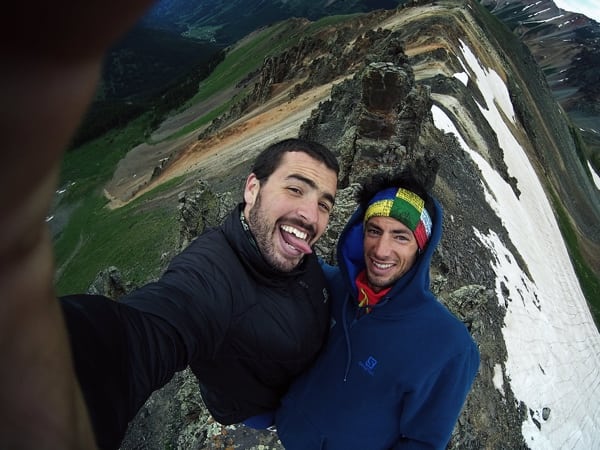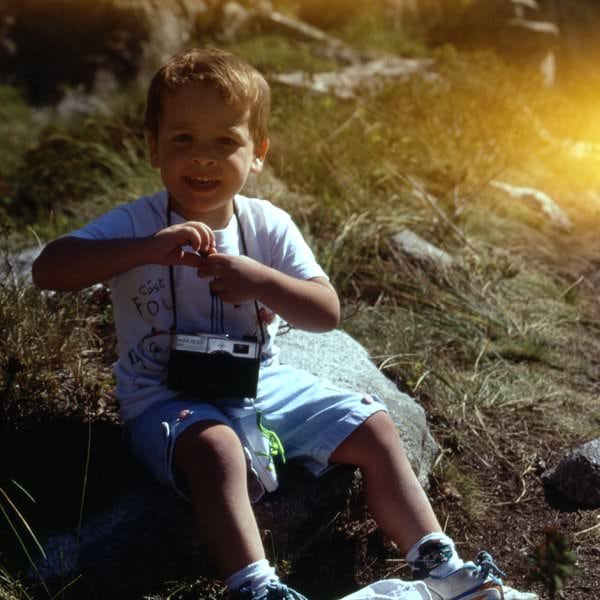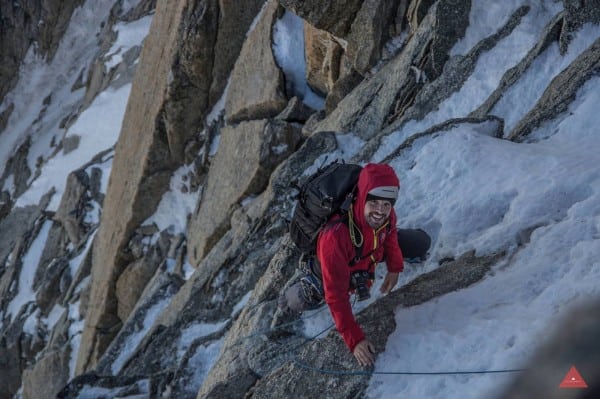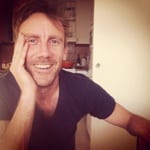As a kid growing up in Barcelona, Spain, renowned trail photographer Jordi Saragossa had two loves—cameras and mountains. He now combines both these passions, traversing the world’s great mountain ranges while chasing the best trail athletes on the planet. No wonder he always looks so-damn happy.

Jordi Saragossa and Kilian Jornet in Colorado’s San Juan Mountains before the 2014 Hardrock 100. Photo: Jordi Saragossa
iRunFar: Jordi, in 2014, you traveled a lot. It seemed like you were popping up at races in every corner of the world. It must have been a good year for you?
Jordi Saragossa: I started the year with an injury to my knee. In the winter I thought that maybe 2014 wouldn’t be so good because I couldn’t run or really walk. I didn’t know if my knee was going to be okay for the season. But then I started with TransGranCanaria in March with the BUFF team, then I went to the Salomon Advanced Week in Limone, Transvulcania, Zegama. That was three out of four races in Spain which was good. Then [laughs], I can’t even remember what came next…
iRunFar: You’ve been a busy guy.
Saragossa: Yeah, I have. I hope this year can be the same—except for the injury part [laughs]. After Zegama, I had the Skyrunning World Championships in Chamonix, then to the U.S. for Hardrock with Kilian [Jornet], then with Frosty [Anna Frost] at Speedgoat. After the U.S., I came home to Barcelona but took photos at the BUFF Epic Trail race—that’s an interesting race. Bad weather last year but, with good weather, it will be excellent. It has very technical trails and is really nice. I was also working at Sierre-Zinal in Switzerland, [Trofeo] Kima, Tromsø Skyrace, and then to The Rut in Montana and finally the Skyrunning finale at Limone[Xtreme]. A lot of travel but really nice.

Hamming it up at the 2014 Zegama Marathon. Photo: iRunFar/Bryon Powell
iRunFar: Is it hard to choose a favourite place where you’ve been?
Saragossa: No, it’s not hard [laughs]! This year was my 13th time in Chamonix; it’s a good place to take photos but after being there so many times it’s not so interesting. Kima is also a really nice race, it’s really technical and I prefer that to just ‘running’ races. Like in Tromsø, I really liked taking photos at the really technical part, on the ridge—for me, that’s the best. The other place that I loved was Hardrock because it was so new for me.
iRunFar: You had some problems with the altitude in Colorado, didn’t you?
Saragossa: Yeah, it wasn’t my first time at altitude, I climbed Mont Blanc and didn’t have problems. I think the problem was that I left home here in Barcelona at sea level and flew to Colorado. In 20 hours, I changed from zero meters to 4000-plus meters living in a cabin in the mountains.
iRunFar: You lived there with Kilian?
Saragossa: [laughs] Yeah, just us. In a cabin in the mountains without water, without electricity—it was pretty funny.

Jordi and Colorado’s San Juan Mountains. Photo: Kilian Jornet
iRunFar: You felt pretty rough up there?
Saragossa: Yeah, the first day I had a little headache and I told Kilian that I had a little pain and that maybe it was the altitude. We thought it was okay and that it would disappear. The second day, more pain but we climbed to the highest part of the course—that probably wasn’t such a good thing to do. Third day, more pain and fever. We didn’t have water in the cabin either, so that was a problem trying to stay hydrated. By the fourth day I had more fever and some blood in my mouth, it wasn’t very funny! Then we decided that we should go to the hospital. The doctor said that maybe I had a pulmonary edema and gave me some pills. He said, “No more altitude for you this week,” but the day after was the race and I needed to take the photos.
iRunFar: You went against doctor’s orders—all for some good photos?
Saragossa: Yeah, I went to a 4000-meter mountain pass and got some great photos but after 20 hours of the race my health wasn’t so good. While I was driving to a new spot to get some more photos, I started to feel very bad and I just had to stop my car because I thought I was going to have an accident. For that reason, I missed the finish-line photo with Kilian! When I got there eventually, everyone was like, “Where were you, are you okay?” A week later, I was perfect again.

Jordi shooting despite having severe altitude sickness during the 2014 Hardrock 100. Photo: iRunFar/Bryon Powell
iRunFar: That’ll be a good story for your grandkids. How did it all begin, Jordi? You’ve been taking photos for as long as you can remember, haven’t you?
Saragossa: Yeah, my father was always taking photos of me. When I was two years old, I had my first camera. I was in the mountains, sitting on a rock with my own camera—a two-year-old kid! My family was always in the mountains at the weekends for hiking to see the lakes. My father, mother, and my brother, and we are always taking photos. It’s funny because when we were hiking, passers-by would tell my father, “Hey, your son is over there taking a lot of photos of the trees, the sky, the stones…” This was before digital cameras so they presumed it was an analogue camera with a roll of film—expensive. My father would say to them, “Don’t worry, there’s no film in there!” I’m pretty sure I was taking some good photos but I’ll never know because there was no film!
iRunFar: You lived in Barcelona then, too?
Saragossa: Yes, I’ve lived in Barcelona all my life. My family had friends with a house in the Pyrenees and we used to go there in the summer. So it was every summer going to the mountains and then, at 15 years old, my brother and I would go to the mountains to get to the summits. It was around then we started to climb. From then we just started doing more and more… Chamonix, all these things.
iRunFar: Was it pretty natural for you to combine mountain sports and photography?
Saragossa: Yeah, for me, I go to the mountains because I love them but I really can’t understand going there without a camera! I feel like I really need to take photos in the mountains. It feels like for me that my life can be exciting and funny but if you don’t take photos and share that, you’re not really living it. There are things that are private, too, but the good things and the nice landscapes, I need to share those.

Two-year-old Jordi in the Pyrenees mountains of Spain, already with a camera in hand. Photo: Zavier Saragossa
iRunFar: Cool. From getting into climbing and combining that with photography as your lifestyle, when did you realise that it could also become your career?
Saragossa: I think when I was 19, I started to study photography. It was during that time that I did an assignment for my teacher. It was a photo report from a nursing home for old people. Afterwards I was like, Wow, I want to do this—explain a story through my photos. It was after that in 2009 that I got the idea to contact Kilian about doing a photo report with him—before, during, and after a race.
iRunFar: Did you already know Kilian then or was that the first time you talked?
Saragossa: I’d been in contact with him earlier in the same year. I’m a member of a mountaineering club here in Barcelona and we had our 10-year anniversary. So I contacted Kilian to see if he would do a talk. In the end we couldn’t organise the talk but that was my first time talking to Kilian. That summer I went to Chamonix and I said to him we should have a beer or something, so it was there where I talked about the idea of doing a photo report with him. It worked out well and was pretty easy to do.

A Catalan moment at Café Mobius in Silverton, Colorado before the 2014 Hardrock 100. Photo: iRunFar/Bryon Powell
iRunFar: I guess it’d be more difficult now. He wasn’t a superstar back then?
Saragossa: No, no. Back in 2009 we could have lunch on a terrace in the centre of Barcelona no problem. Now, that would be impossible. Now here, in Catalonia, he’s famous, he appears on the telly in advertisements!
iRunFar: You’ve been photographing trail running since 2009, you must have seen big changes in the sport in the last five to six years?
Saragossa: When I started it was pretty normal. The last three years have seen big changes. I think it surprised everybody. The best thing for me now is that we’re awaiting the next generation of trail runners. The generation now, Kilian, Anna Frost, and the others are getting a little older and now we will see a change of generation. I think that will be great because I’m still here taking photos but I will see these young athletes coming up. The next generation also knows that trail running is a big thing, with a lot of exposure and a lot of people.

Jordi, Kilian Jornet, and Aleix Domenech goofing around at the 2013 Kilian’s Classik. Photo: Jordi Saragossa
iRunFar: It’s a good point. I guess the generation that are dominating now, they didn’t know that the sport was going to boom, while the next generation knows what to expect in a lot of ways. Maybe they’ll have a different approach?
Saragossa: I think so. Look at football, if you are a football player and are playing for the second or third level at FC Barcelona, you know that if you can make it to the first team, you will be famous. When someone like Kilian started this, he didn’t think about being famous! He just wanted to run. The new athletes, they know that if they can be good, good athletes they can be famous. It’s really different.
iRunFar: What about yourself, Jordi? How has it changed for you as a photographer with regard to covering the events? Are there big changes there, too?
Saragossa: I think the biggest change is that there were just two or three other photographers doing this. Now I feel that people are like, “Okay, here’s somewhere I can work and maybe get some money.” Because it’s a sport that’s growing, numbers are increasing all the time. All the races now have 10 or 12 photographers—everyone knows that it’s a good time to start working in trail running. That’s the big change. There are also photographers who do the work for free, so it’s more difficult to work and earn money because you can find a good photographer who will work for free or for not a lot of money.

Sharing with Núria Picas’s two boys at the 2014 Zegama Marathon. Photo: iRunFar/Bryon Powell
iRunFar: Does that mean the atmosphere has become more competitive amongst the photographers or is there still a good rapport amongst you guys?
Saragossa: It’s a friendly atmosphere. The new photographers kind of look up to us and say, “You’re the ones that started this!” It’s funny, they have some admiration and say things like, “I love your work…” and are a little inspired by us. It’s friendly but we also have to try and explain that it’s a job. Yes, we are in the mountains, it’s beautiful, we’re free, and it’s great work but you need to invoice this! Otherwise everything will go down. You know, you’re in the mountains with a lot of gear, that’s worth a lot of money… if that get’s wet, then your gear dies. So you need to invoice for your work.
iRunFar: Your personal work, Jordi, your style of photography, how would you describe your style?
Saragossa: I think my style is changing all the time. I look at Damien [Rosso]’s photos, at Ian [Corless]’s photos, Seb [Montaz]’s photos… lots of other people’s photos for inspiration. I’m also learning things and changing all the time. At first, all my photos were at an angle—now I don’t like that! I can’t really define my style but maybe the fact that I’m living with athletes—I’m more like a friend who’s just around, the athletes don’t think about me and I never direct the photos when it’s a report. I’m just there and they are doing their thing.

Looking for the shot at the 2012 Cavalls del Vent. Photo: Quim Farrero
iRunFar: Yeah, I guess that your photos convey a definite familiarity and laid-back feeling with the athletes. What about video, Jordi? A lot of people talk about video being an essential skill for the modern working photographer, what’s your take on that?
Saragossa: For me, I’m not so into video. I always say I’m a photographer, not a videographer. It’s a really different world. For video, you have to shoot a lot of hours and it’s really difficult to shoot video and take photos—it’s not compatible. My work is taking photos. I do some video with small GoPro-style cameras but it’s more to show the making of a certain shot that I can use when I do talks. I can explain that here is the final shot but here with the video I can show what was happening behind the camera, you can see that we’re friends and it’s relaxed… we’re like a family! I did a couple of videos at Transvulcania and Chamonix last year, too, that were more behind-the-scenes and funny, living with the athletes. I think the people want to see these other things, funny things with the athletes.
iRunFar: Cool. What’s the future hold for you, Jordi? Any dreams left to fulfill?
Saragossa: I’m living the dream now! When I was a kid my first dream was to travel a lot. I wanted to become a National Geographic photographer so I could see the world. I’m not a Nat Geo photographer now, but I’m traveling a lot. I’m going all over the world, it’s crazy. Plus I’m doing it with friends. I don’t want to think of the future because I want to enjoy these moments, now!

Climbing with Kilian Jornet and Emelie Forsberg at Arête des Cosmiques (Aiguille du Midi, Chamonix, Alps) in 2014. Photo: Kilian Jornet
